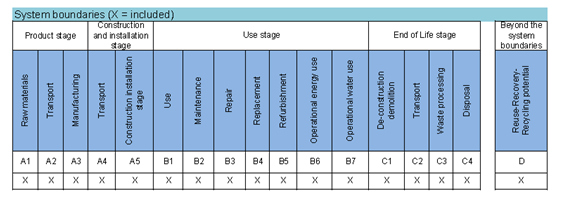
The ABCs of EPDs
By Tom O’Sullivan, Technical Specification Advisor, NorDan UK Ltd
When I joined NorDan UK as a Technical Specification Advisor in 2020, one of the aspects that I found most appealing was that the company had Environmental Product Declarations (EPD).
Why appealing?
Because the EPDs demonstrated that NorDan’s much talked about sustainability credentials were genuine, but also because EPDs are increasingly valued by customers, architects and specifiers.
And why surprising?
In my ten years in industry I’d yet to come across a manufacturer of NorDan’s stature that had gone to such lengths to quantify the whole life carbon in the majority of their products.
Prior to joining the business I’d worked as an architectural designer for a local authority, for various architecture practices and ran my own business, so I was very much on the ‘other side’ of the fence to my current role at NorDan.
Requesting and calculating the embodied and operational carbon in building products and materials was a big part of my job so it was interesting to note that product manufacturers were at very different stages on their journey into sustainability and transparency.
Some of the larger suppliers had EPDs and calculations on a limited number of their products, while others presented their own carbon analysis without third party verification which made comparison and analysis rather difficult.
What’s an EPD?
In short, an EPD is a transparent, objective report that clearly explains what a product is made of, and how it impacts on the environment across its entire life cycle.

This includes measuring the embodied carbon, which covers everything from raw materials, manufacturing processes, transport (the product stage), through to the transport to site and onsite installation (construction stage) – and finally the disposal of the product at the end of life stage.
An EPD also shows how much recycled material is used in a product. For example, the EPD lists that the aluminium cladding on NorDan’s Alu-Clad Timber Window frames contains 25% recycled materials, while 18% of the glass is from recycled sources.
Understanding and reducing embodied carbon is increasingly important in the construction industry, and many of the big players recently backed an attempt to regulate emissions in the proposed Part Z of the Building Regulations.
As a result many architects and specifiers are now selecting products and materials that cut embodied carbon now and deliver an immediate carbon benefit.
EPDs also provide the operational carbon performance of the product (or the use stage), which explains how it will benefit a building’s energy efficiency. Sustainability is about balancing both operational and embodied carbon, an improvement in terms of operational carbon often has a negative effect on the embodied carbon used to produce a product (switching from double to triple-glazing for example).
EPDs: A carbon audit
In a way, EPDs are a bit like a carbon version of an audited annual tax return.
While an accountant will complete a financial audit and submit an annual report to HMRC, an EPD is recognised evidence that a qualified, third party has systematically worked through all the relevant data on a product and signed-off on the findings.
In NorDan’s case, our declarations are undertaken by Norwegian EPD Foundation EPD- Norge, which bases its measurement on: “scientific methods and international standards.”
EPDs are consistent, transparent and verified, so the customer can more easily compare the environmental performance of products from across the market.
So why don’t all manufacturers have EPDs on their products?
In fairness, producing an EPD is a significant time and cost commitment, and some products are more complicated to measure than others. Fortunately, NorDan has focused on sustainability since the 1960s which means that producing EPDs was an obvious decision for the business.
Sustainably grown timber is a natural carbon sink, and many of NorDan’s products are carbon negative - removing more carbon from the atmosphere than they produce.
The end of life stage on our products is also extended way beyond the norm, as all of our products have a 60 year minimum life-span.
It’s also fair to say that NorDan is in a fortunate position when it comes to the whole life carbon because our embodied carbon is low and our operational performance is high so it makes sense to share this information with our client and architects.
You can view NorDan’s EPDs on our various product pages, but if you ever need any assistance in deciphering the various sections and carbon breakdowns then do get in touch, I’m happy to help.
Please feel free to email me at tom.o’sullivan@NorDan.co.uk
Find out why we have a Window of Opportunity in construction.
